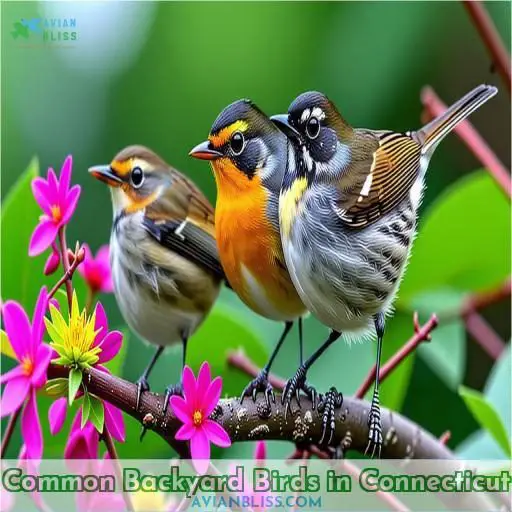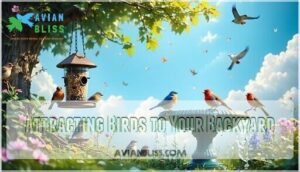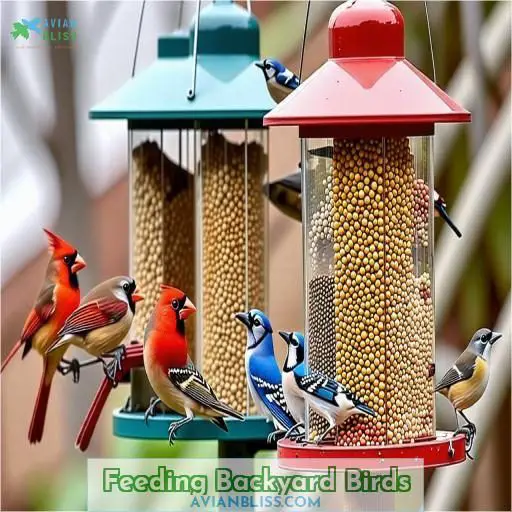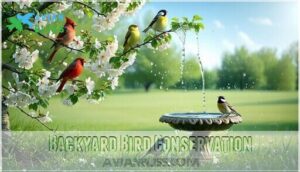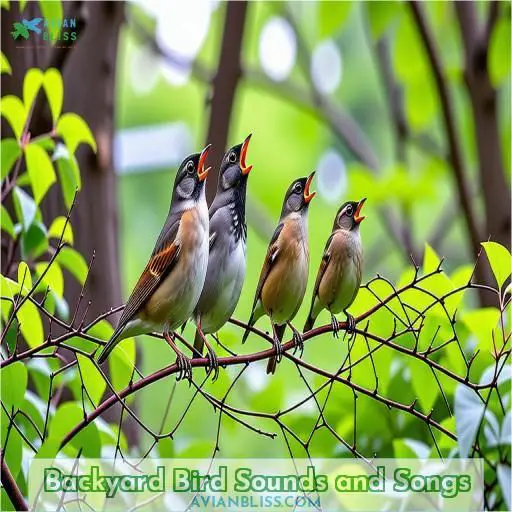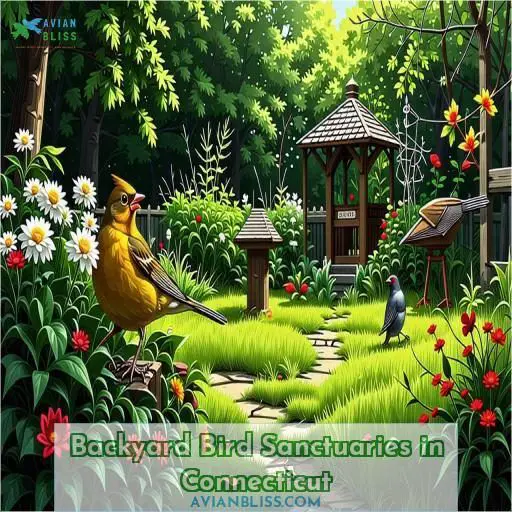This site is supported by our readers. We may earn a commission, at no cost to you, if you purchase through links.
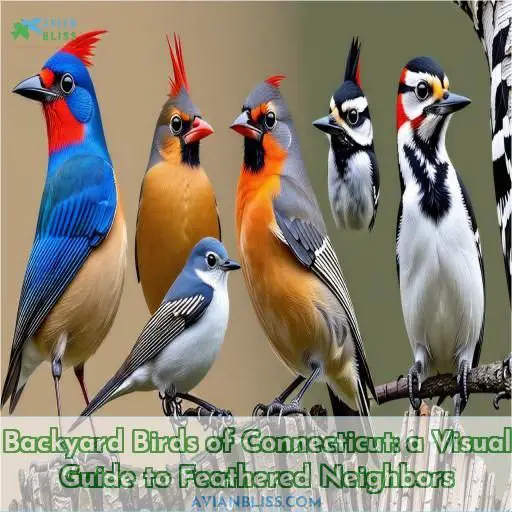
Connecticut’s diverse landscapes play host to an array of feathered visitors. From the vibrant American Goldfinch to the melodious Carolina Wren, these avian neighbors will captivate you with their distinct plumages, behaviors, and songs.
Attract them to your yard by providing food, water, and shelter sources like native plants and nesting boxes.
Get ready to begin an exciting journey of identifying and appreciating the backyard birds of Connecticut – their stories are just waiting to unfold before your eyes.
Table Of Contents
- Key Takeaways
- Common Backyard Birds in Connecticut
- Identifying Backyard Birds
- Attracting Birds to Your Backyard
- Feeding Backyard Birds
- Nesting and Breeding Behaviors
- Migratory Patterns of Connecticut Birds
- Backyard Bird Conservation
- Backyard Bird Photography
- Backyard Bird Sounds and Songs
- Backyard Bird Sanctuaries in Connecticut
- Frequently Asked Questions (FAQs)
- How do I identify a bird in my backyard?
- How do I know what birds are in my area?
- What birds stay in Connecticut for the winter?
- What is the bright yellow little bird in Connecticut?
- What is the bright red bird with a black mask?
- Which bird has a blue head and black body?
- What is the large white wading bird in Connecticut?
- Which bird has a yellow body and black wings?
- What is the black bird with red shoulder patches?
- Conclusion
Key Takeaways
- Connecticut’s diverse landscapes host a variety of vibrant and melodious backyard birds, from the American Goldfinch to the Carolina Wren.
- Attracting birds to your backyard involves providing food sources, water, and shelter through native plants, nesting boxes, and feeders stocked with seed mixes and suet.
- Many backyard birds in Connecticut are migratory, undertaking seasonal journeys between breeding and wintering grounds, influenced by factors like food availability and climate.
- Habitat loss, fragmentation, and various threats endanger bird populations, prompting conservation efforts through Important Bird Areas and citizen science initiatives for monitoring and protecting backyard birds.
Common Backyard Birds in Connecticut
You’re likely familiar with several colorful and melodious backyard birds in Connecticut. From the vivid yellow plumage of the American Goldfinch to the distinctive black mask of the Carolina Wren, these feathered neighbors enliven our outdoor spaces with their beauty and song.
American Goldfinch
You’ll often spot the vibrant American Goldfinch at your feeder, with its:
- Bright yellow body and black cap
- Short, conical beak perfect for cracking seeds
- Lively, undulating flight pattern
- Sweet, musical call notes
These cheerful little birds thrive in open, weedy areas, feasting on thistles, sunflowers, and nyjer seed. Their late summer nesting coincides with peak seed abundance.
American Robin
You’ll likely spot the familiar orange-breasted American robin foraging for worms on your lawn. These abundant thrushes nest in shrubs and trees, favoring suet, fruit, and insects. Listen for their cheerful cheer up, cheerily song heralding spring. Though many migrate south for winter, some robins remain year-round in Connecticut. (Source)
Baltimore Oriole
The Baltimore Oriole, a striking member of the New World Warbler family, graces Connecticut backyards with its vibrant orange and black plumage. These acrobatic birds weave intricate hanging nests and serenade with their flute-like songs. Look for them in open woodlands and parks, often near water sources. Offer halved oranges and grape jelly to attract these beauties to your feeders .
Barn Swallow
The Barn Swallow, a graceful aerial acrobat, graces Connecticut’s backyards with its iridescent blue back and forked tail. These social birds nest in small colonies under eaves and bridges, crafting mud nests lined with grass and feathers. Barn Swallows migrate annually to South America, feasting on insects along the way. Conserving open habitats is key to their survival.
Black-capped Chickadee
The Black-capped Chickadee is a familiar sight in Connecticut backyards, known for its wintering habits and distinctive black cap. They display molting patterns, courtship behaviors, and territorial instincts. However, conservation challenges persist, affecting chickadees, nuthatches, old world flycatchers, and sparrows alike. Sight records document these behaviors, shedding light on the interconnected nature of avian conservation efforts.
4 Items to Draw the Audience In:
- Exposing the Winter Survival Tactics of the Chickadee
- Dissecting the Courtship Dances of the Black-Capped Chickadee
- Uncovering the Complex Territorial Behaviors of Connecticut’s Avian Residents
- Addressing Conservation Challenges for the Black-Capped Chickadee and its Avian Neighbors
Blue Jay
The striking blue feathers of the Blue Jay make it a standout in any backyard.
These intelligent birds build cup-shaped nests in trees and shrubs, using twigs, grass, and mud.
They thrive in wooded areas and parks, feeding on acorns, nuts, seeds, and insects.
Blue Jays are known for their loud, harsh calls and aggressive behavior toward hawks, cormorants, bitterns, and new world vultures.
Their mating rituals involve elaborate courtship displays and pair-bonding behaviors.
Brown-headed Cowbird
The brown-headed cowbird is a common backyard bird in Connecticut known for its parasitic nesting habits. These birds prefer open habitats like fields, parks, and urban areas. Cowbirds lay their eggs in the nests of other species, a behavior called brood parasitism. To protect cowbirds, support conservation efforts and provide diverse habitats in your backyard.
Carolina Wren
The Carolina Wren, a vibrant reddish-brown bird with a distinctive white eyebrow, is a common sight in Connecticut backyards.
Known for its loud, cheerful song, this wren is a year-round resident that builds domed nests in sheltered spots.
Providing dense shrubs and suet feeders can attract these energetic insect-eaters to your yard.
Though adaptable, Carolina Wrens face threats from habitat loss and predation.
Cardinal
The vibrant red male Northern Cardinal is a beloved backyard visitor in Connecticut. Its cheerful whistle and crest make it easy to spot. Cardinals are year-round residents, nesting in dense shrubs and eating seeds, berries, and insects. To attract them, offer sunflower seeds, provide water, and plant native berry bushes. Enjoy their lively presence and beautiful song!
- Striking red plumage of males
- Cheerful, whistled song
- Resident year-round in Connecticut
- Nest in dense shrubs and trees
- Eat seeds, berries, and insects
Common Grackle
The common grackle, a striking blackbird species, can be found nesting in Connecticut.
Its diet consists of insects, fruits, and grains, making it a versatile feeder visitor.
Their vocalizations are diverse, with calls including a range of sounds.
As an introduced species in some areas, the common grackle plays a unique ecological role.
However, it’s not an extinct species and is classified as a rare or accidental species in some regions.
Identifying Backyard Birds
To effectively identify backyard birds, you’ll need to closely observe their key physical features, such as size, shape, color patterns, beak structure, and distinctive markings. Additionally, pay attention to their behaviors, movements, habitats, and vocalizations, as these unique characteristics often provide important clues for accurate species recognition.
Key Physical Features
Avoid discussing things which would be discussed in the NEXT SUBTOPIC entitled ‘Habitat and Location‘.
Behavior and Movement
Observing a bird’s behavior and movement can provide valuable clues for identification.
Look for unique flight patterns like the undulating flight of the American Goldfinch or the rapid wing beats of the Barn Swallow.
Watch for mating rituals like the courtship displays of the Blue Jay or the territorial songs of the Carolina Wren like the teakettle-teakettle song.
Seasonal changes in behavior, such as the arrival of snow buntings in winter, can also aid identification.
Always practice birdwatching etiquette by keeping a respectful distance and minimizing disturbance to the birds.
Habitat and Location
When identifying backyard birds in Connecticut, it’s key to account for their habitat preferences and geographic distribution to observe them effectively. Urbanization effects and suburban development shape the distribution of bird species, influencing birdwatching hotspots. Understanding the specific habitats each species prefers can enhance your birdwatching experience and contribute to bird conservation efforts in this diverse region.
Vocalizations and Songs
- Trills and whistles of the Eastern Towhee’s drink your tea
- Cheerful chatter of the Northern Cardinal’s cheer cheer cheer purdy purdy purdy
- Laughing yodel of the White-breasted Nuthatch
- Buzzy tsee tsee tsee of the Black-capped Chickadee
- Haunting hoots of the Great Horned Owl
Attracting Birds to Your Backyard
To attract a diverse array of feathered visitors to your backyard, you’ll want to provide a variety of food sources, including seed, suet, and nectar feeders, as well as sources of fresh water for drinking and bathing. Creating shelter through the planting of dense shrubs and leaving brush piles offers nesting sites and protective cover.
Providing Food Sources
Offering a variety of food sources is key to attracting a diverse array of backyard birds.
Install seed feeders stocked with black oil sunflower seeds, nyjer, and millet to attract finches, chickadees, and sparrows.
Suet cakes provide high-energy nutrition for woodpeckers, nuthatches, and titmice.
Hummingbird feeders filled with nectar will delight these tiny acrobats.
Incorporate native plants that produce berries and seeds to provide natural food sources.
Offering Water
Offering a reliable water source is key to attracting birds to your backyard. Install birdbaths at varying heights, keeping them clean and filled with shallow, fresh water. Provide heated water in winter to help birds conserve energy. Make sure water is available year-round for summer hydration and winter survival. Strategically place baths near cover for birds’ safety.
Creating Shelter and Nesting Sites
To attract birds to your backyard, provide shelter and nesting sites. Install nesting boxes and birdhouses of varying sizes to accommodate different species. Create brush piles using fallen branches and leaves for ground-dwelling birds. Leave loose bark on trees to attract insects for woodpeckers. Plant native shrubs that offer dense cover and nesting materials.
Native Plants and Trees
To enhance your backyard as a bird-friendly habitat, consider planting native trees and plants. Native flora attracts beneficial insects, essential for a thriving ecosystem. Incorporate species like Red Maple, Eastern Redbud, and Serviceberry in your landscaping to create a diverse and enriching environment for birds. Opt for bird-friendly landscaping choices to support avian populations and enhance habitat quality.
| Red Maple | Eastern Redbud | Serviceberry |
|---|---|---|
| Deciduous Tree | Small Flowering Tree | Berry-producing |
| Attracts Pollinators | Colorful Spring Blooms | Fruit for Birds |
Feeding Backyard Birds
To attract a diverse array of feathered visitors to your backyard, it’s crucial to provide a variety of bird feeders stocked with suitable seed mixes and nutrient-rich suet cakes. For hummingbirds, make a simple nectar solution by mixing one part white sugar with four parts water, and hang specialized feeders near flowering plants to entice these tiny, hovering birds.
Types of Bird Feeders
To attract a variety of backyard birds in Connecticut, offer a selection of feeders specially designed to meet their preferences. Hang tube feeders for finches, hopper feeders for larger birds, and suet cages for woodpeckers. Place feeders near cover but away from windows to prevent collisions. Clean feeders regularly to maintain a safe environment for your feathered friends .
- Tube feeders for finches
- Hopper feeders for larger birds
- Suet cages for woodpeckers
Seed Mixes and Suet
When making seed mixes for backyard birds, consider a variety of seeds like sunflower, safflower, and millet to attract a diverse range of bird species. For suet feeders, a simple recipe typically includes suet or lard, along with bird seed ingredients. Make sure the suet cake recipe has a suitable fat content to provide necessary energy for the birds.
Hummingbird Nectar
Hummingbirds are attracted to nectar with a sugar composition similar to that of flowers.
Make a simple sugar solution of 1 part white sugar to 4 parts water, boil it, and let it cool before filling your nectar feeders.
Avoid using red dye or honey, which can harm hummingbirds.
Clean feeders regularly and change the nectar every few days to keep it fresh and free of mold.
Feeding Schedules and Placement
To guarantee successful backyard bird feeding, consider using different seed types in various feeder placements.
Adjust feeding frequency based on bird behavior and weather conditions.
Sunflower seeds attract a variety of species, while thistle seeds are favored by finches.
Place feeders strategically, near cover, to offer birds protection.
Adjust feeding schedules, increasing frequency during extreme cold or heavy snow.
Observation of bird behavior indicates preferences, aiding in feeder placement.
Nesting and Breeding Behaviors
You’ll want to pay close attention to the nesting materials and behaviors of backyard birds during their breeding season. Carefully observing how different species construct their nests from twigs, grass, feathers and other materials, as well as their incubation periods, hatching process, and caring for nestlings and fledglings, will provide fascinating insights into their intricate parenting routines.
Nest Building Materials
Backyard birds use a variety of natural and man-made materials to construct their nests, including twigs, grass, moss, feathers, and even human hair.
Check that these materials are safe for birds by avoiding anything treated with chemicals.
Properly dispose of nesting materials to prevent litter and create habitat for other wildlife.
Reduce waste by providing natural nesting options like untreated cotton balls or pet fur.
Incubation and Hatching
During incubation, birds diligently warm their eggs to facilitate egg development. Parental roles are critical as they take turns to nest the eggs, ensuring hatching success. The nest’s location plays a significant role in providing security and ideal conditions for incubation. The incubation period varies among bird species but is essential for the embryo to develop properly.
Nestling and Fledgling Stages
Once the eggs hatch, nestlings emerge blind and helpless. Featherless and with closed eyes, they rely on their parents for warmth, protection, and food. Nestlings grow rapidly, developing feathers and opening their eyes within days. After about two weeks, they’re ready to leave the nest as fledglings, though still dependent on parental care and feeding .
Parental Care and Feeding
Once the nestlings hatch, both parents take turns feeding and caring for their young.
The nestlings beg for food by opening their mouths wide and making high-pitched calls.
Parents share the duties of finding insects, worms, and seeds to bring back to the nest.
As the nestlings grow, they become more vocal in their demands for food.
Fledglings continue to be fed by parents for some time after leaving the nest.
Migratory Patterns of Connecticut Birds
Many backyard birds in Connecticut are migratory, undertaking seasonal journeys between their breeding and wintering grounds. Factors like food availability, day length, and temperatures influence their migrations, and citizen science projects help monitor these remarkable avian travelers.
Spring and Fall Migrations
Spring and fall migrations are vital for understanding the migratory patterns of Connecticut birds.
Birdwatching enthusiasts contribute to scientific efforts, observing and documenting these movements.
Climate change impacts and habitat restoration play significant roles in these migrations.
Understanding birdwatching ethics guarantees that these natural events are appreciated without disrupting or harming the birds.
Citizen science contributions aid in thorough tracking of these seasonal movements.
Resident Vs. Migratory Species
Some birds, like the Black-capped Chickadee and Northern Cardinal, are year-round residents in Connecticut, while others, such as the Ruby-throated Hummingbird and Barn Swallow, are migratory, arriving in spring and departing in fall. Many species, like the Dark-eyed Junco and American Tree Sparrow, are winter visitors, spending the colder months in the state before heading north to breed .
Factors Influencing Migration
Birds migrate to take advantage of seasonal changes in food availability and climate. As temperatures warm in spring, birds head north to breed where there are abundant insects and nesting sites. In fall, birds fly south to escape harsh winters and find food. Habitat loss and climate change disrupt these ancient patterns, making migration more perilous .
Monitoring Migration Through Citizen Science
Monitoring migration patterns of Connecticut birds through citizen science involves data collection and analysis.
Citizen science initiatives enable volunteers to observe and report bird sightings, contributing to a thorough understanding of migration behaviors.
This data is vital for conservation initiatives, aiding in the identification of important bird areas and the development of strategies to protect and preserve the diverse bird populations in Connecticut.
Backyard Bird Conservation
As you embrace the beauty of backyard birds, it’s vital to acknowledge the challenges they face. Habitat loss, fragmentation, and various threats endanger bird populations, prompting organizations like Audubon to identify Important Bird Areas and promote citizen science initiatives for monitoring and conservation efforts.
Habitat Loss and Fragmentation
Habitat loss and fragmentation are major threats to Connecticut’s backyard birds. As forests are cleared for development and farmland is converted to suburban sprawl, birds lose the shelter, nesting sites, and food sources they need to thrive. Invasive species, climate change, and pollution further disrupt delicate ecosystems. Protecting and restoring habitats is essential for conserving backyard bird populations.
Threats to Bird Populations
Backyard birds face numerous threats, including habitat loss from development, climate change disrupting food sources, invasive species outcompeting natives, pollution contaminating water and food, and human disturbance through pesticides and outdoor cats. Protecting backyard habitats, using native plants, and keeping cats indoors helps safeguard these feathered friends. Together, we can create a haven for backyard birds to thrive.
Audubon’s Important Bird Areas
In Audubon’s Important Bird Areas (IBAs), designated for avian preservation, habitat protection is paramount. These areas facilitate species monitoring and conservation through IBA designations. By prioritizing these essential habitats, bird populations flourish. Citizen science plays an integral role in monitoring and maintaining the well-being of these areas, highlighting the importance of community involvement in avian conservation.
Citizen Science and Monitoring
Citizen science projects allow you to contribute valuable data on backyard birds. Monitor your feeders through programs like Project FeederWatch, or participate in annual counts like the Christmas Bird Count. Your observations help track population trends and inform conservation efforts. Get the whole family involved in this rewarding way to support your feathered neighbors!
Backyard Bird Photography
For successful backyard bird photography, you’ll need a camera with manual controls and a telephoto lens that allows you to capture detailed shots from a distance.
Attracting birds close to your shooting location with feeders, water sources, and native plants not only increases your chances of great shots but also lets you practice ethical, low-impact photography without disturbing the birds’ natural behaviors.
Camera Equipment and Settings
When capturing backyard birds on camera, the right camera lenses are essential. Consider lenses suitable for bird photography, like telephoto lenses . Optimize image composition by focusing on the bird’s eye, use leading lines to draw attention, and fill the frame with the bird (Source). Adapt to changing lighting conditions to achieve the best shots and always respect ethical and legal guidelines .
Attracting Birds for Photography
To attract birds for photography, strategically place feeders and baths near perches and cover. Offer a variety of seeds, suet, and fruit. Use multiple feeders to reduce competition. Position feeders 10-15 feet from cover to allow birds to feel safe. Avoid sudden movements and wear neutral colors. Be patient and let the birds acclimate to your presence.
| Tip | Description |
|---|---|
| Feeders | Use multiple feeders with different seed types |
| Perches | Place feeders near natural perches like branches |
| Cover | Provide nearby shrubs and trees for birds to retreat to |
Ethical and Legal Considerations
When photographing backyard birds, always prioritize their welfare.
Avoid disturbing nests, feeding stations, or roosting areas.
Make certain your presence doesn’t alter their natural behaviors.
Respect local laws and regulations regarding wildlife photography.
Never bait or lure birds with food solely for photos.
Maintain a respectful distance and use telephoto lenses to capture stunning images while minimizing stress to your feathered subjects.
Composition and Lighting Techniques
To capture stunning backyard bird photos, use composition techniques like the rule of thirds and leading lines. Lighting is key – shoot in soft, even light and experiment with backlighting. Adjust aperture for desired depth of field and shutter speed to freeze motion. Patience and practice will help you master natural light techniques for breathtaking results (Source).
Backyard Bird Sounds and Songs
As you embark into the realm of backyard birding, attuning your ears to the delightful melodies and distinct calls becomes an invaluable tool for identifying the feathered visitors.
From the cheerful warbles of the American robin to the distinctive whistles of the cardinal, each species possesses a unique vocal repertoire.
This vocal repertoire not only varies with the seasons but also serves as a means of communication within their avian communities.
Identifying Birds by Their Calls
When identifying backyard birds by their calls, focus on bird vocalizations and behavior to understand their habitat.
Bird calls are essential for communication and can be learned through vocal learning.
Pay attention to the distinct songs each species produces.
By recognizing these unique calls, you can identify different birds in your surroundings accurately.
Understanding bird communication enhances your connection with the feathered visitors.
Seasonal Changes in Vocalizations
As the seasons change, so do the vocalizations of backyard birds in Connecticut. Their vocal repertoire adapts to environmental cues, with song complexity peaking during breeding season . Geographical differences in dialects may also emerge**, as birds learn from their local flock . Tune in to the ever-changing symphony of your feathered neighbors throughout the year .
Birdsong and Communication
Bird songs are complex vocal patterns used for communication, conveying information about a bird’s species, sex, age, and social status. Listening closely, you can identify birds by their unique songs and calls. Decoding these avian conversations reveals fascinating insights into the lives of your feathered neighbors. Mastering birdsong opens a window into the hidden world of backyard birds.
Backyard Bird Sanctuaries in Connecticut
Connecticut boasts several renowned backyard bird sanctuaries managed by the Audubon Society, including the Audubon Center at Bent of the River, the Audubon Center in Greenwich, and the Sharon Audubon Center.
These sanctuaries offer ample opportunities to observe and appreciate a diverse array of avian species through guided walks, educational programs, and carefully maintained checklists and field guides designed for their respective locations.
Audubon Center at Bent of the River
Discover the Audubon Center at Bent of the River, a haven for priority species and a hub for habitat restoration efforts through bird banding. Engage in citizen science projects and contribute to wildlife conservation. Explore diverse bird species and immerse yourself in the beauty of nature.
- Participate in bird banding activities.
- Engage in citizen science for wildlife monitoring.
- Support habitat restoration projects for priority species.
Audubon Center in Greenwich
The Audubon Center in Greenwich is a 295-acre sanctuary with 7 miles of trails through diverse habitats like forests, fields, and wetlands. It’s a prime spot to spot birds like hawks, eagles, and owls during migration. The center offers educational programs and resources to help you attract and protect birds in your own backyard. Visit and discover your feathered neighbors!
Sharon Audubon Center
The Sharon Audubon Center, an important bird sanctuary in Connecticut, offers valuable birdwatching tips and contributes notably to bird conservation efforts.
This center is instrumental in habitat restoration and hosts a diverse range of bird species, making it a prime location for observing and appreciating local avian wildlife.
Visitors can benefit from the center’s expertise in bird diversity and conservation practices.
Species Checklists and Guides
The Audubon sanctuaries in Connecticut provide detailed checklists to help you identify the common backyard birds in your area. These guides cover key identification features, habitat preferences, and typical behaviors to look for. Use them to learn about the feathered friends visiting your yard and how to attract more of these delightful neighbors .
Frequently Asked Questions (FAQs)
How do I identify a bird in my backyard?
Around 23% of bird species face extinction. To identify birds, you’ll need a field guide and binoculars. Note key details like size, color patterns, behavior, and calls for cross-referencing in the guide. With practice, bird identification becomes intuitive and deeply rewarding.
How do I know what birds are in my area?
To identify birds in your area, consult local bird guides, use birding apps, or join local birding groups that can provide regional insights on species and habitats.
What birds stay in Connecticut for the winter?
Imagine the quiet serenity of a winter morning, bird feeders adorned with resilient feathered companions. Several species like cardinals, chickadees, and juncos bravely endure Connecticut’s chilly embrace.
What is the bright yellow little bird in Connecticut?
That bright yellow little bird you’re spotting is likely the American Goldfinch, a common backyard visitor known for its vibrant plumage and cheerful song. Its coloring is unmistakable during breeding season.
What is the bright red bird with a black mask?
That vibrant crimson-red beauty with the distinctive black mask is the beloved Northern cardinal. A true treat to spot in your backyard!
Which bird has a blue head and black body?
As the old adage goes, A picture is worth a thousand words. The Blue Jay, with its striking blue crest and black body, is a sight to behold in any backyard.
What is the large white wading bird in Connecticut?
You’re likely spotting the Great Egret, a statuesque white heron often seen wading in wetlands, marshes, and coastal areas across Connecticut.
Which bird has a yellow body and black wings?
The American Goldfinch symbolizes nature’s vibrant beauty with its vivid yellow body and striking black wings, a delightful sight in your backyard.
What is the black bird with red shoulder patches?
That’s the Red-winged Blackbird, a striking bird with glossy black feathers and vibrant red patches on its shoulders. You’ll often spot these feisty songbirds perched on cattails near marshes and fields.
Conclusion
Ultimately, observing backyard birds of Connecticut transcends mere birdwatching; it cultivates a profound appreciation for nature’s marvels. Though initially challenging, identifying and understanding these feathered wonders fosters an enduring connection with your local environment. Embrace this rewarding pastime, for the sights and sounds of Connecticut’s avian residents will enrich your life in unforgettable ways.

